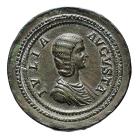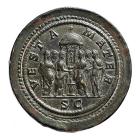The Civico Gabinetto Numismatico e Medagliere di Milano (The Civic Numismatic and Medal collection of Milan) is composed of two important coin and medal collections, one owned by the City of Milan and one a state-owned collection, named "Brera" after the Palazzo di Brera where it was held until 1919. In that year, after long negotiations between the State and the City, the Numismatic Collection was transferred from the Palazzo di Brera to the Sforza Castle, where, although remaining separate, it joined the City’s medal collection
The Numismatic and Medal Collection
The numismatic collections are dual in nature. The State depository (Brera) came into existence under the auspices of Cattaneo, who in the period between 1801 and 1813 founded and organized the Numismatic collection. He made important purchases of coins and medals, both ancient and modern from all over Europe, with the aim of providing the Institute with holdings that would illustrate the development of coins from the beginning of coinage (6th century BC) to the time in which he lived. On the other hand, the original core of the Civic holdings, constituted primarily through a number of major donations between the period of the Restoration and the 1930s and 40s, focuses mainly on coins and medals produced in Milan and Lombardy, with only some holdings centred on other areas of Italy and abroad. Following the First World War, the collections were expanded through the purchase or donation of various sets of coins: a significant part of the Gerin collection of Vienna, consisting of about 9000 pieces from the Late Roman Empire; the Laffranchi collection, consisting of around 23.000 imperial Roman coins; the Rosa collection, including approximately 1200 Greek bronze coins; the Sabetta collection, made up of around 1701 examples of 4th century Roman coins and the Rolla collection of around 1800 Roman coins.









